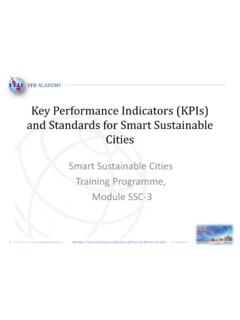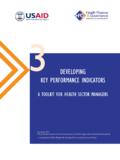Transcription of Asset Integrity Programme
1 A report by the Offshore Division of HSE s Hazardous Installations DirectorateHealth and Safety ExecutiveKey Programme 3 Asset Integrity Programme1 of ## pagesHealth and Safety ExecutiveKey Programme 3 Asset Integrity Programme2 of 27 pagesContents Preface4 Glossary4 Part 1 Executive summary5 Part 2 Introduction8 Part 3 Analysis of of management of the maintenance management state of critical system of performance according to installation Discussion of specific template element issues of SCEs/measuring compliance withperformance factors affecting performance and of project work on 4 Underlying issues and consideration for improvement27 Part 5 Good practice30 Part 6 References39 Appendix 1 Aims and objectives41 Appendix 2 Inspection Programme background43 Appendix 3 Results483 of 71 pagesKey Programme 3.
2 Asset Integrity ProgrammeHealth and Safety ExecutivePrefaceThis report has been produced to communicate the results and conclusions of theAsset Integrity Key Programme carried out between 2004 and 2007 by the Healthand Safety Executive s Offshore report is available on the HSE s Offshore Oil and Gas website The traffic light matrix associatedwith this report can be downloaded separately as an Excel low as reasonably practicableCAPEXC apital expenditureCEOC hief executive officerCRAC orrosion risk assessmentESDVE mergency shutdown valveFPSOF loating production storage and offloadingFPFloating productionHVACH eating ventilation and air conditioningHSLH ealth and Safety LaboratoryICPI ndependent competent personIMTI nspection management teamsIIWGI nstallation Integrity work groupIVBI ndependent verifying bodyKP3 Key Programme 3 KPIKey performance indicators MAH Major accident hazardsMMSM aintenance management systemNUIN ormally unattended installationORAO perational risk assessmentOSD Offshore
3 DivisionPSPerformance standardsQRAQ uantified risk assessmentRBIRisk based inspection RRResearch reportSPCSemi-permanent circularSCES afety-critical elementTATechnical authorityTRTemporary refugeUKCSUK Continental ShelfUKOOAU nited Kingdom Offshore Operators Association (now known asOil and Gas UK Ltd)WOWork order4 of 71 pagesKey Programme 3: Asset Integrity ProgrammeHealth and Safety Executive1 Executive summaryThe offshore oil and gas industry on the UK Continental Shelf (UKCS) is a matureproduction area.
4 Much of the offshore infrastructure is at, or has exceeded, itsintended design life. Between 2000 and 2004, HSE s Offshore Division (OSD) ran amajor Programme KP1 aimed at reducing hydrocarbon releases and focusing on theintegrity of process plant. This resulted in a considerable reduction in the number ofmajor and significant hydrocarbon releases. During this time, however, OSD becameincreasingly concerned about an apparent general decline in the condition of fabricand plant on installations and responded with Key Programme 3 (KP3) directedmore widely at Asset Integrity , and scheduled to run between 2004 and 2007.
5 Asset Integrity can be defined as the ability of an Asset to perform its requiredfunction effectively and efficiently whilst protecting health, safety and theenvironment. Asset Integrity management is the means of ensuring that the people,systems, processes and resources that deliver Integrity are in place, in use and willperform when required over the whole lifecycle of the involved targeted inspections of nearly 100 offshore installations representingabout 40 per cent of the total. These included all types including fixed, mannedand normally unattended installations, floating production (FP), floating productionstorage and offloading (FPSO) vessels and mobile drilling rigs.
6 It involved all ofOSD s Specialist and Inspection Management Team inspectors and all levels ofmanagement. Essential for the Integrity of any installation are the safety-critical elements (SCEs).These are the parts of an installation and its plant (including computerprogrammes) whose purpose is to prevent, control or mitigate major accidenthazards (MAHs) and the failure of which could cause or contribute substantially to amajor accident. KP3 focused primarily on the maintenance management of SCEs,ie the management systems and processes which should ensure that SCEs wouldbe available when inspection Programme was structured using a template containing 17 elementscovering all aspects of maintenance management, and a number of SCE systemstests.
7 An element covering Physical State of Plant , was also included allowing theinspection team s judgement on the general state of the platform to be performance , on inspection, of each template element was scored using atraffic light system (explained in Appendix ) which enabled overall installationperformance to be recorded on a matrix. This in turn enabled an overview ofcompany and industry performance to be obtained and examples of good and badpractice clearly identified. It was encouraging to find a number of examples of goodand best practice and these have been shared with the industry and have also beenincluded in the report.
8 The template and traffic light system has since been adopted by other NationalRegulators. Independent Verification Bodies, employed to verify the performance ofSCEs on the UKCS, have also adopted the template and carried out independentinspections on behalf of the light of the findings from KP3, Asset Integrity will continue to be one of OSD smain priorities in 2008 and for the foreseeable of 71 pagesKey Programme 3: Asset Integrity ProgrammeHealth and Safety ExecutiveMain findings and lessons learnedThe main findings and lessons learned from the Programme are.
9 Maintenance management systemsnThe performance of management systems showed wide variations across were often considerable variations in performance between assets in thesame company as well as between state of the plant was often not understood because of the complexity ofcatagorising and recording equipment which was overdue for maintenance orfound to be improvement in maintenance systems could be achieved withoutmajor capital expenditure by better planning, improved training and clearstatement of performance standards in testing and maintenance routines.
10 NThere is a poor understanding across the industry of potential impact ofdegraded, non-safety-critical plant and utility systems on safety-criticalelements in the event of a major accident. nThe role of Asset Integrity and concept of barriers in major hazard risk control isnot well use of operational risk assessments (ORAs) to compensate for degradedSCEs is often not well technical authority role needs to be strengthened in many industry is not effectively sharing good and best practice. This isparticularly evident in that companies were not learning the well-publicisedlessons gained during the life of KP3.

















